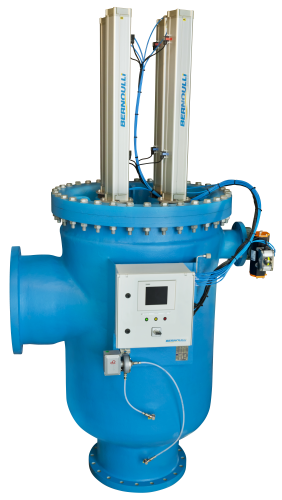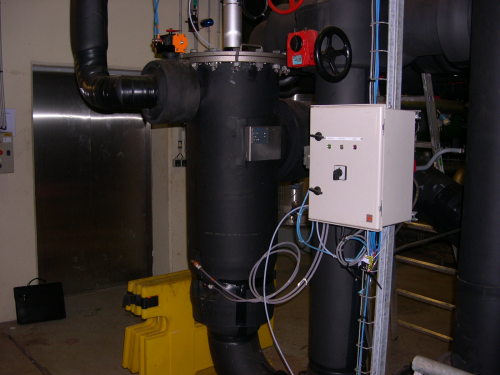

In a world with limited supplies of fresh water, and with water quality under constant pressure, cooling equipment and processes using seawater and other low-quality water from sources such as rivers, lakes and canals is essential and widely accepted. However, solving one challenge creates another: in this case, preventing particles in low-quality cooling water from causing excessive fouling and expensive down time. This is where the Bernoulli Filter comes in.
The filter protects a wide range of sensible process equipment from clogging and fouling, and, in addition, continuously and automatically filters raw water in pressurised systems.
Multi-basket product range
In detail, the BMG product line is the first member of the multi-basket product range. It consists of four models DN 400 to DN 800, covering a capacity range of up to 8400 m3/h. Thanks to the use of multiple filter baskets in one filter body, fine filtration down to 100 microns is achievable, even at high flow rates. This means that one single multi-basket unit is capable of doing the work of multiple smaller single basket units. The result is a space efficient installation that requires less piping.
The BMG product line benefits from the use of GRP (Glass fibre Reinforced Polyester) as filter body material, which is the superior material of choice for seawater applications. The multi-basket Bernoulli Filters can be manufactured in several steel materials to comply with specific requirements and needs.
Where does it fit?
The purpose of a Bernoulli Filter is to reduce the load of particles in natural water sources, and therefore pre-treatment of raw water-like surfaces or sea water is a straightforward application. The Bernoulli Filter works as a pre-filter and acts as an additional protection for finer filtration technologies such as Ultrafiltration and Multimedia filtration. Within desalination, the Bernoulli Filter plays an important part acting as a pre-filter before the reverse osmosis (RO) process where potable water is produced from saline water for domestic and municipal purposes.
How it works
The Bernoulli filter is an 'ingenious design' for water filtration, the company states. The filter works on Bernoulli´s principle – the 270-year-old discovery that an increase in the velocity of the flow of a liquid gives rise to a drop in pressure. A specially-shaped flushing disc mounted on a pneumatic cylinder is introduced into the filter basket, which creates an increase in the velocity of the flow between the disc and the wall of the basket. The resulting drop in pressure “vacuums” away the particles that have attached themselves to the inside of the basket.
The impurities are flushed out through a flushing valve, and problems due to the clogging of the basket are avoided. The flushing sequence is conducted in two steps. First, the flushing valve opens and large particles are flushed out. Second, the cylinder with its flushing disc moves twice into the basket, removing the particles adhering to it. The flushing sequence is initiated by either a timer or a differential pressure switch.
Bernoulli: A brief history
The company was founded in 1986 as 'Seacool AB' and set as its objective to design and develop sea water cooling systems. At that time, corrosion resistant titanium had become popular in heat exchangers and the pipe systems were often build in plastic material. However, automatic filters were still built-in materials susceptible to corrosion. In addition, effective filtration is vital to prevent heat exchangers from clogging.
Seacool, as the company was then known, invented the 'revolutionary' filter with a concept based on Daniel Bernoulli's equation formulated in the 18th century. The concept enabled manufacturing of filters in plastic material and the patented design was introduced in 1990 as a component of sea water systems.
The product was named the Bernoulli Filter, and in 1996 Seacool AB changed its name to 'Bernoulli System AB'. Today the company reports that the filters are used in a large number of applications globally, with installations in over 80 countries.
Global applications
The Bernoulli Filter has been utilised across the world, and for a detailed insight into one of its applications please read the Case Study panel on this page. The Filter has also been used in other projects, including:
The Copenhagen Opera House, Denmark
The indoor climate of Copenhagen's Opera House is controlled by a HVAC system that uses sea water from the Oresund as a cooling medium.To be able to accomplish this, the heat exchangers in the HVAC system need to be protected from getting clogged by dirt or organic growth from the sea. It was decided to use three BSG 150 Bernoulli Filters for the intake of cooling water to the HVAC system of the Opera House.
QAFCO Fertiliser Plants, Qatar
The main cooling system for the fertiliser plants is provided by heat exchanged sea water. However, the plate heat exchangers cannot be directly operated with sea water as an incoming cooling medium because of the natural debris of sea weed, etc. that is taken in along with the sea water.
Since beginning work with QAFCO in 1999, over 50 Bernoulli Filters have been installed, forming a foundation for the successful operation of the plate heat exchangers and consequently for the entire fertiser production.
Tanjung Bin Power Station, Johor, Malaysia
The operation of the power plant requires a huge amount of cooling capacity provided by sea watercooling of the process water, by heat exchanging. However, the plate heat exchangers cannot be directly operated with sea water due again to natural debris. By installing six BSG Bernoulli Filters with titanium filter baskets at the power station, filtering of up to 20,000m3/h sea water has been achieved.•
www.bernoulli.se
Case study – District Cooling System, Paris
In Paris’s city centre GDF Suez owned Climespace operates one of the largest district cooling systems with its six production plants. Commissioned in 2002, the Canada production plant is located near the banks of the Seine and is entirely underground, which is a substantial advantage given its urban environment.
The plant utilised plate heat exchangers which were fitted with automatic backwash filters to prevent debris in the River Seine’s water from clogging them. The backwash filters required an external flow of clean flushing water, which was provided by a manual classic Y-strainer. Unfortunately, the Y-strainer often became clogged and had to be manually cleaned. This in turn interfered with the backwashing of the backwash filters. The flow rate of river water across the plate heat exchanger dropped and the cooling capacity of the system deteriorated. Climespace had to regularly open and clean the manual filters, which was additional, time-consuming work.
In 2006 Climespace decided to test a Bernoulli Filter type BSS 250 with a filtration degree of 0.5 mm to replace the existing Y-strainer. After nine months of continuous operation without manual cleaning, the Bernoulli Filter was opened and found to be almost free from solid contaminants. Maintenance and personnel costs had fallen while plant performance had improved. A second Climespace production plant, the Halles plant, has since been fitted with Bernoulli Filters.




